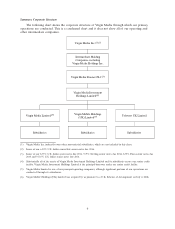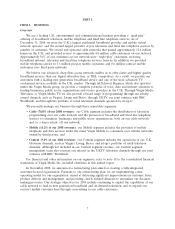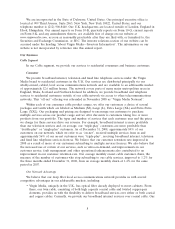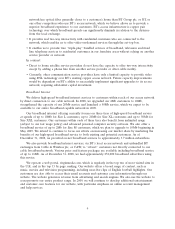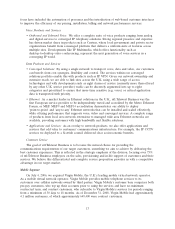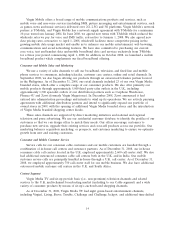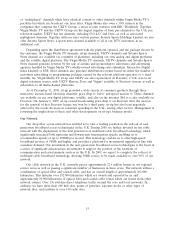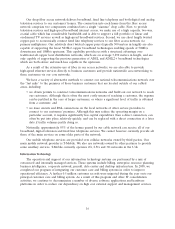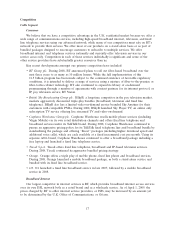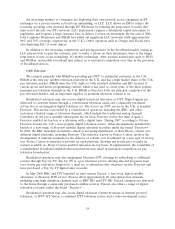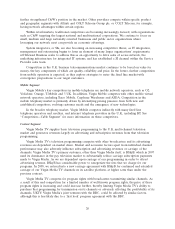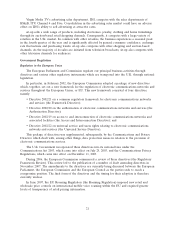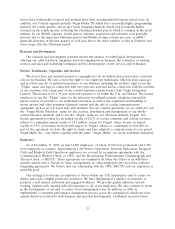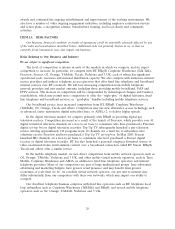Virgin Media 2008 Annual Report Download - page 18
Download and view the complete annual report
Please find page 18 of the 2008 Virgin Media annual report below. You can navigate through the pages in the report by either clicking on the pages listed below, or by using the keyword search tool below to find specific information within the annual report.Our deep fiber access network delivers broadband, fixed line telephony and both digital and analog
television services to our customers’ homes. The connection into each home from the fiber access
network comprises two components combined into a single ‘‘siamese’’ drop cable. First, to provide
television services and high-speed broadband internet access, we make use of a high capacity, two-way,
coaxial cable which has considerable bandwidth and is able to support a full portfolio of linear and
on-demand TV services as well as high-speed broadband services. Second, we use short length twisted
copper-pair to economically connect fixed line telephony services to our fiber access network via
primary multiplexers. Our relatively short twisted copper pairs (typically 500 meters in length) are also
capable of supporting the latest VDSL2 copper broadband technologies enabling speeds of 50Mb/s
downstream and 10Mb/s upstream. This capability provides us with a structural advantage over
traditional all copper local distribution networks, which are on average 3,250 meters in length, and are
only capable of supporting the previous generation of ADSL and ADSL2+ broadband technologies
which are both slower and much less capable in the upstream.
As a result of the extensive use of fiber in our access networks, we are also able to provide
high-speed ethernet services directly to business customers and provide nationwide area networking to
these customers via our core networks.
We have a variety of alternative methods to connect our national telecommunications network over
the ‘‘last mile’’ to the premises of those business customers that are located outside of our cabled
areas, including:
• we obtain permits to construct telecommunications networks and build out our network to reach
our customers. Although this is often the most costly means of reaching a customer, the expense
can be justified in the case of larger customers, or where a significant level of traffic is obtained
from a customer; and
• we lease circuits and DSL connections on the local networks of other service providers to
connect to our customers’ premises. Although this may reduce the operating margin on a
particular account, it requires significantly less capital expenditure than a direct connection, can
often be put into place relatively quickly, and can be replaced with a direct connection at a later
date if traffic volumes justify doing so.
Nationally, approximately 95% of the homes passed by our cable network can receive all of our
broadband, digital television and fixed line telephone services. We cannot however currently provide all
three of the main services on some older parts of the network.
Our mobile telephone services are provided over cellular networks owned by third parties. Our
main mobile network provider is T-Mobile. We also use networks owned by other partners to provide
some ancillary services. T-Mobile currently operates 2G, 2.5G and 3G networks in the U.K.
Information Technology
The operation and support of our information technology systems are performed by a mix of
outsourced and internally managed services. These systems include billing, enterprise resource planning,
business intelligence, corporate network, payroll, data center and desktop infrastructure. In 2008, we
completed our program of integrating our customer care and billing systems in order to improve
operational efficiency. A further 0.5 million customer records were migrated during the year onto our
principal customer care and billing system. As a result of this program and other IT consolidation
activities, we continue to decommission a number of diverse software applications and hardware
platforms in order to reduce our dependency on high cost external support and management services.
16


